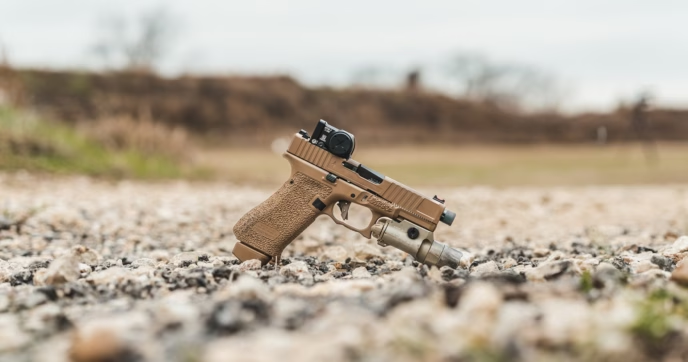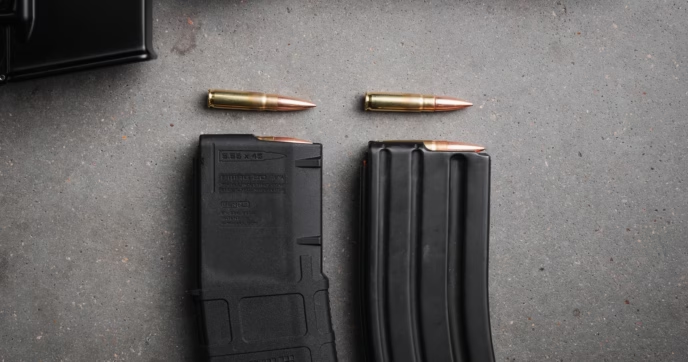Beefed Up Black Rifles: 300 Blackout Vs. 7.62x39mm
The AR-15 was designed around the .223 Remington / 5.56 NATO cartridge to achieve a very specific purpose. The lighter, smaller cartridge meant that soldiers could carry more ammunition into the field than the enemy. Greater firepower through quantity. However, in today’s market where the AR platform is more customizable than ever, people are opting more and more to move away from the smaller 5.56 NATO and upgrade to some higher-powered cartridges.
The venerable 7.62×39 cartridge was the direct competition responsible for the AR-15’s adoption of the 5.56 NATO cartridge. The heavier, bulkier bullet is famously known for its service in the Russian SKS, AK-47 and other former Soviet rifles. The cartridge’s slanted walls are responsible for the iconic banana shape of 7.62×39 magazines so readily brought to mind in images of AK-47s in conflict. In recent years, this cartridge and their magazines have found a new home in modified AR platform rifles.
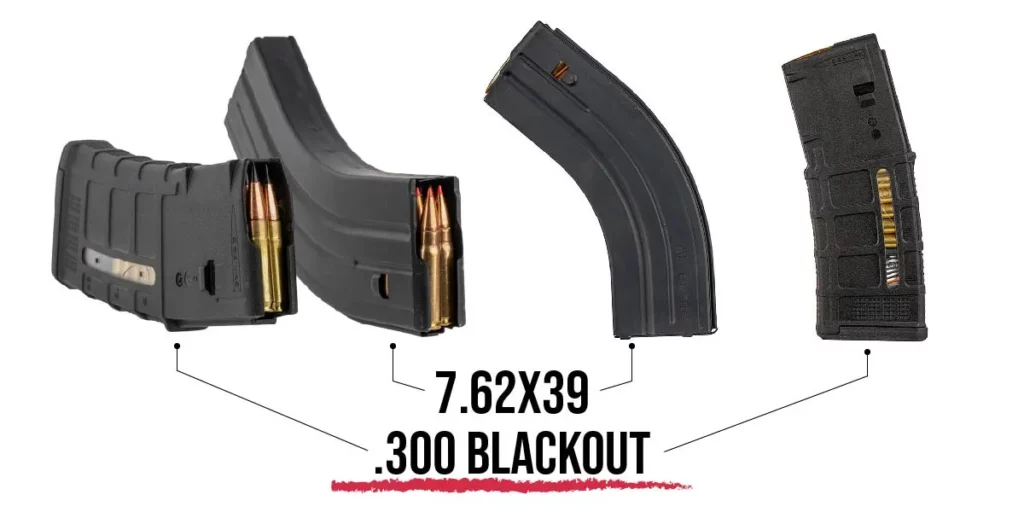
In much more recent years, a newcomer has arrived on the scene. The .300 Blackout cartridge was developed by Advanced Armament Corporation and was approved by SAAMI in 2011. It was designed to function reliably firing subsonic ammo from short barrels while being compatible with standard AR-15 / M4 upper receivers with a standard bolt and bolt carrier. Oh, and it also had to fit in magazines made for 5.56 NATO rounds without sacrificing capacity. It was a tall order, but ever since its release many have flocked to the 300 Blackout to put .30-caliber power in their AR-15s.
While ballistically they can be very similar, as you’ll see below, there are some benefits and drawbacks to each of these cartridges when being fired from an AR-15 platform. If you’re trying to decide which round to use for your next high-powered AR build, let us break down the pros and cons of each.
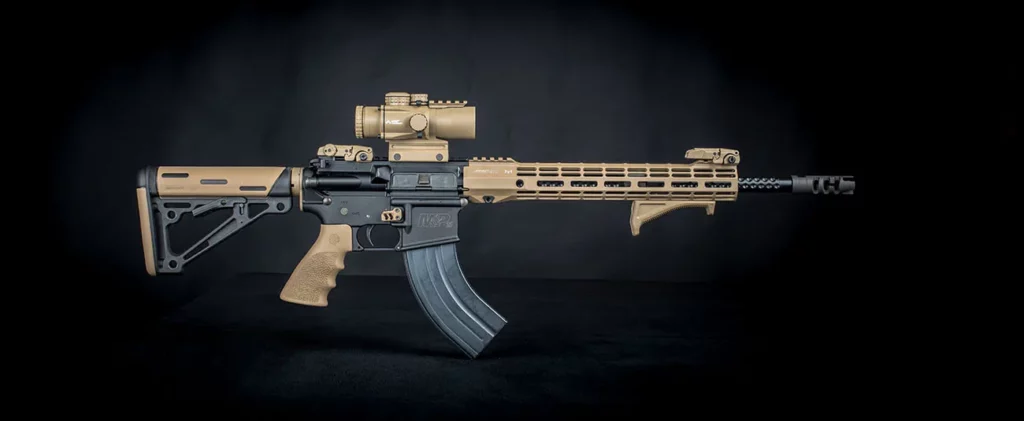
The 7.62×39 Cartridge
The common warfighting rifle of WWII was large, heavy, and not very nimble. However, with effective ranges of 600 yards or more, these rifles were extremely capable fighting weapons and infantrymen used them with skill and precision. They were chambered for larger rounds we still see today, like the .30-06 Springfield. These rifles and the men that fought with them were often aided by soldiers with submachine guns firing pistol-caliber rounds, which were easier to handle when engagements were shorter in range than 100 yards and automatic fire provided the advantage. The 7.62×39 cartridge was meant to bridge the gap between these two ranges and give soldiers the best possible combination of short range effectiveness – especially when using automatic fire – and still retain the ability to effectively engage targets out to about 300 yards. These are the demands most modern combat calibers seek to meet.
The benefits of the 7.62×39 are numerous, if not sometimes misconstrued. The cartridge has long had a reputation for being a cumbersome, inaccurate round. The truth of the matter is, this reputation may very well have more to do with the way this round has been employed in military service rather than the round’s characteristics themselves. The AK-47 is first and foremost a fighting rifle. Sub-MOA accuracy is probably not something that ever crossed the minds of Mikhail Kalashnikov or the Soviet Russian engineers in the factories originally responsible for churning them out as fast as possible in twilight of World War II. Can better accuracy be achieved from this round when fired from a custom-built AR platform rifle? Absolutely. That’s the beauty of the AR – its modular design helps you put together the parts you need to achieve the performance you want.
This does bring up another issue, however. Because bullet diameters are measured and regulated differently around the world – and because so many ammunition manufacturers around the world make this round – there are discrepancies in bullet diameter that could potentially cause problems. Most American-made 7.62x39mm bullet diameters measure .308”, but some Russian or Chinese manufacturer diameters could be as large as .311” or .312”. When building an AR in 7.62×39, be sure you know the specifics of your barrel’s bore measurements and match your ammunition and bolt carrier group to that measurement. Another drawback that’s inherent to the 7.62×39’s widespread use and production around the world, and subsequent imprecise standardization, is the potential for reliability issues. Some 7.62×39 parts just don’t play as nicely together as they should. Some factory ammunition doesn’t cycle as well with this bolt carrier or that barrel, or any number of things that make up a build. Things are getting better with time, especially as 7.62×39 AR-15s become more popular, but there’s always the chance that once your build is finished, there will be some part that needs to be swapped out or taken to a gunsmith, and that can get expensive real quick.One of the largest benefits of the 7.62×39 round is its cost. Due to its ubiquitous use all around the world, cheap surplus ammunition can be found very easily, for as little as 20 cents per round. In addition to the cheap stuff, though, many companies do offer match-grade quality loadings for 7.62×39. If you look around on YouTube for AR-47 style rifle builds, you’re sure to find some builders achieving near-MOA groups at 100 yards if not better. Most loadings you’ll find commercially available range from around 120 grain to 125 grain loads, with the most common bullet weight being 123 grain.
Ballistically, the 7.62×39 and 300 Blackout are very similar when using similar loadings. The benefit that 300 BLK has over 7.62×39 is in the realm of flexibility, with more bullet offerings to choose from including subsonic rounds. Each round is roughly comparable to common loadings of .30-30 Winchester ammunition at a popular 150 grain bullet weight. (See a full ballistic breakdown at the end of this article.)
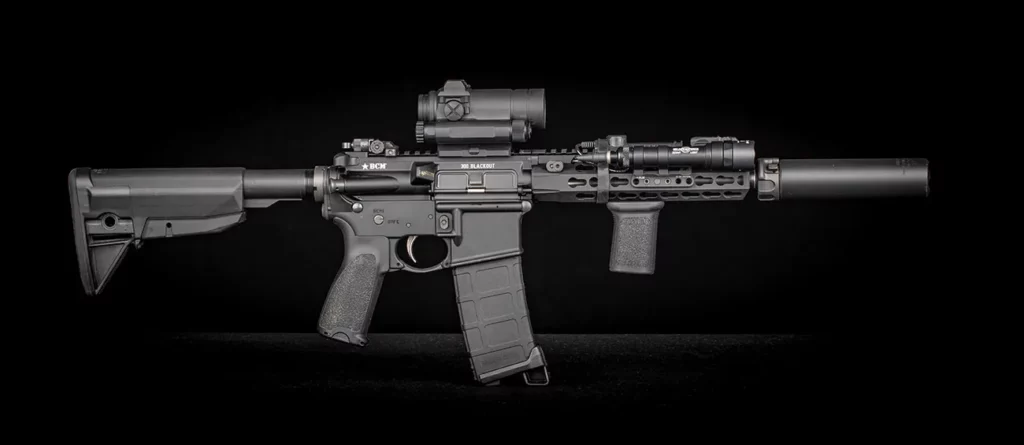
The .300 AAC Blackout Cartridge
The 300 BLK’s story begins the same way many other popular short action cartridges do – especially those designed to elevate the capabilities of the AR-15. Quite simply, the U.S. Military wanted more thump. Advanced Armament Corporation wanted to give it to them and do so in a way that could be optimized for suppressed fire. They started with the .300 Whisper wildcat cartridge — which was first documented and trademarked in 1992 with the Commission Internationale Permanente pour l’Epreuve des Armes a’ Feu Portatives (CIP) — made some slight modifications and applied for Sporting Arms and Ammunitions Manufactures Institute standardization, allowing it to be mass produced by many manufactures in the United States. The Whisper and the Blackout are very similar, though Blackout has achieved more commercial success in The States.
The advantages of the Blackout cartridge are numerous — probably most important is its compatibility with standard MIL-SPEC AR-15 and M4 parts. Because it’s rim is the same size as 5.56 NATO cartridges, the Blackout uses the same bolt, and thus same bolt carrier group, as any off-the-shelf AR-15. The bullet’s dimensions also allow it to fit, double stacked, in standard 5.56 magazines, unlike the 7.62×39 with its tapered case wall. This, however, can also be a negative, as it is possible to be careless and accidentally end up with a stray 300 BLK round in your magazine of 5.56 NATO. As you can imagine, this mistake can be incredibly catastrophic, even deadly. So pay attention and keep your ammo and magazines stored and used completely separate from each other. If you want to change a standard MIL-SPEC 5.56 AR rifle into a .300 Blackout rifle, the minimum requirement is a new .30-caliber barrel, with many shooters opting to build a dedicated 300 BLK complete upper receiver that can then be swapped onto a 5.56 lower when needed.
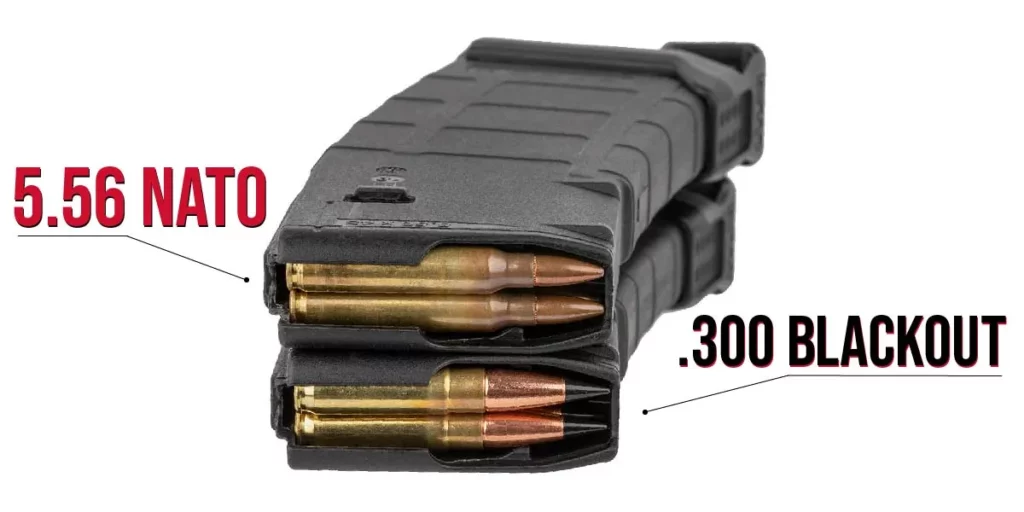
The generally larger bullet size – in higher bullet weights especially – and the smaller, straight-walled casing of the 300 BLK in comparison to the 7.62×39, means there’s less propellant pushing the round down the barrel. The smaller case capacity means all the propellant is expended in about 10 inches of barrel. This can be a benefit for people who want to build AR pistols or SBRs, especially with a suppressor. A better bullet design, especially in hunting and self-defense rounds, makes up for those set-backs in terms of ballistics to a degree. But, as you’ll see below, the 7.62×39 narrowly outpaces the 300 BLK in terminal performance at all effective ranges. The 300 BLK’s main ballistic advantage comes in its ability to shoot slightly flatter and buck the wind more effectively. In certain set-ups, those differences might be fairly minimal.Flexibility is the 300 BLK’s biggest win over 7.62×39. With factory loaded bullet weights ranging from 78 grains to 220 grains, you can tailor your bullet to your needs – especially subsonic rounds for suppressor-friendly use which is becoming ever more popular. Lightweight loads might extend your effective range a bit, but at the expense of terminal energy. Heavy, subsonic loads will carry far less kinetic energy and limit your range, but they’ll be a dream to shoot through a suppressor. So, with 300 BLK, you have options. The thing about options, though, is that you’re going to have to pay for them. 300 BLK rounds are going to be more expensive than 7.62×39 ammunition as a general rule. In a bulk purchase, it’s possible to get down to about 43 cents per-round according to a quick Google search, but the average cost is usually a lot more than that. It’s not uncommon at all to pay 1 dollar or more per shot. The cost of flexibility, we suppose.
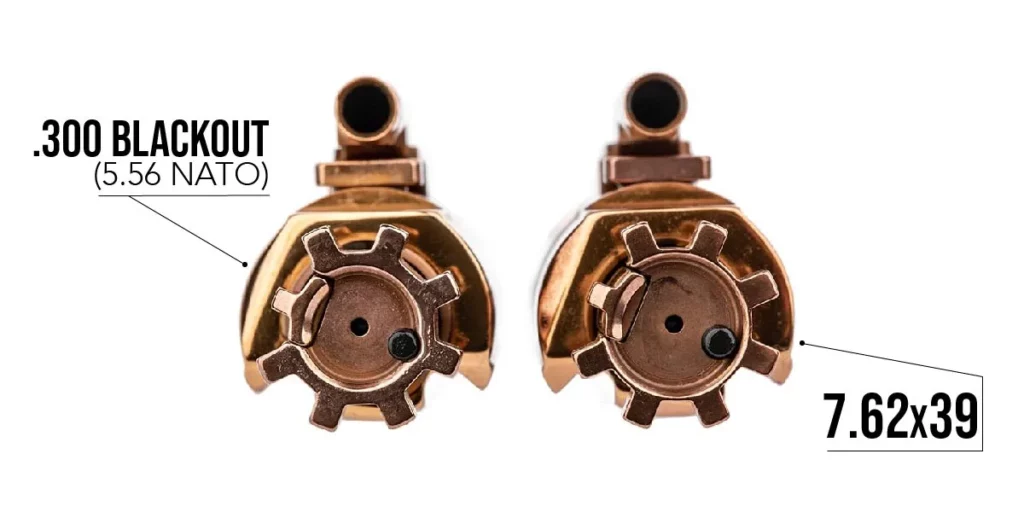
The answer to this question — which to choose between 300 Blackout or 7.62×39 — ultimately comes down to what purpose you’re intending this rifle to have. For example, in a home defense scenario, the heavy, subsonic 300 BLK bullet will carry more energy than some common handgun rounds like 9mm and even .45 ACP, and the bullet’s large expansion diameter can prevent dangerous over-penetration of walls or other objects within a home. If the rifle you’re planning to build is going to be more of a tool for keeping the hogs or coyotes at bay around your property, or if you’re just looking to shoot a lot at the range, perhaps the cheaper cost of ammunition will steer you towards the 7.62×39. It’s as close to a toss-up ballistically as any caliber comparison you’re going to find, so the deciding factors are going to be the extra things we’ve discussed. Either choice you make, you’ll be getting hard-hitting performance out to medium ranges with your AR-15.
Ballistic Breakdown
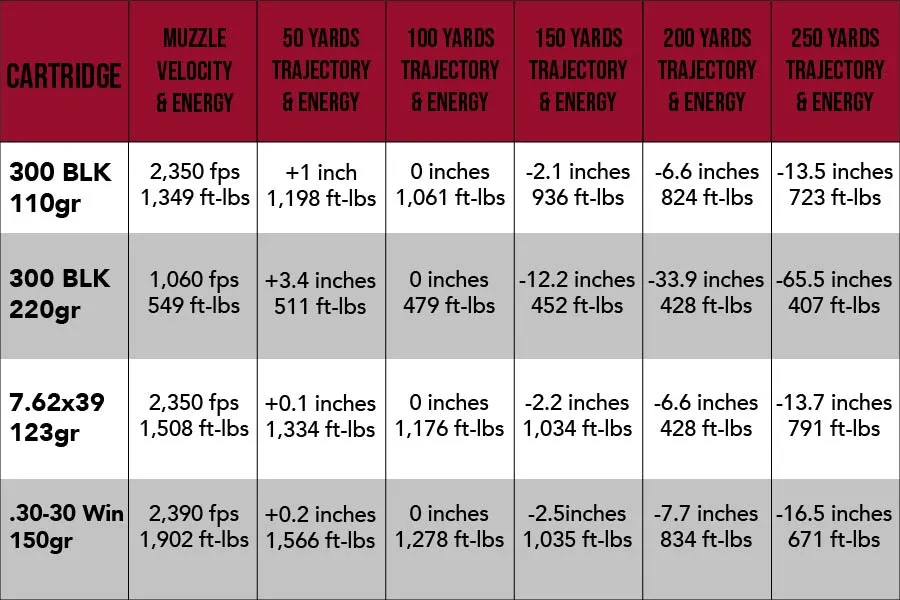
As you can see, the numbers are relatively similar. The lighter weight 300 BLK and the 7.62×39 bullet both exit the barrel with the same velocity, when shot from the appropriate length barrels. When compared to the .30-30 Winchester, initial velocity is very close. However, the .30-30 is packing the most energy by a pretty wide margin, and the 7.62×39 out-punches the 300 BLK by a slimmer, though not insignificant, advantage. The really drastic difference is with heavy subsonic 220gr 300 BLK bullets, as is to be expected. Across the board we see far less energy, velocity, and a rainbow-like trajectory by comparison, even as it retains its energy better than all the rest, percentage-wise. These rounds are best used for a specific purpose like self- or home-defense where potential engagement ranges are short, and the benefit of a suppressor is of greater value. If there’s any victory to be had for 300 BLK it’s in the fact that it’s bullet wasn’t designed over half a century ago. It’s a ballistically superior bullet by any account, even if that does mean it only gets close to the numbers put up by its Russian opponent. The fact that a .30-caliber bullet can even come close to comparable performance in an smaller casing with less propellant is a testament to this fact. So, the benefits 300 BLK enjoys are a slightly better overall retention of energy percentage-wise and a slight advantage in bullet drop and ability to fight the wind. All other benefits of the 300 BLK over the 7.62×39 are outside the arena of ballistics.
So… What’ll it be?
Again, your use-case is going to dictate the type of AR rifle you build. Determine the scenarios in which you anticipate putting this rifle to use and evaluate your needs. If you’d like our outright professional opinion, it’s relatively straight-forward: build one of each!



